The role of linear energy transfer in modulating radiationinduced NF-κB activation and its down-stream target genes

The role of linear energy transfer in modulating radiationinduced NF-κB activation and its down-stream target genes

| dc.contributor.advisor | Hemmersbach, Ruth | |
| dc.contributor.author | Chishti, Arif Ali | |
| dc.date.accessioned | 2020-04-20T00:03:13Z | |
| dc.date.available | 2020-04-20T00:03:13Z | |
| dc.date.issued | 23.07.2014 | |
| dc.identifier.uri | https://hdl.handle.net/20.500.11811/6128 | |
| dc.description.abstract | To enable long-term human spaceflight, the cellular radiation response to heavy ions with a high linear energy transfer (LET) needs to be better understood for developing appropriate countermeasures to mitigate acute effects and late radiation risks for the astronaut. The biological effectiveness of accelerated heavy ions in provoking DNA damage response pathways as a gateway to cell death or survival is of major concern not only for spaceflight but also for new regimes of tumor radiotherapy. It has been shown that NF-κB, the main actuator in inflammation and immune response, can be activated by DNA double strand breaks (DNA damage dependent subpathway) and is discussed to contribute to anti-apoptosis and survival improvement of cells containing residual DNA damage after ionizing irradiation. The biological relevance of the recently discovered LET depencency of NF-κB activation is unknown, especially the resulting profile of NF-κB target gene expression. Therefore, the effect of heavy ions of a broad LET range (0.3-10,000 keV/μm) on cellular survival, regulation of the cell cycle and activation of NF-κB and the induction of its target genes were investigated. Furthermore, the role of NF-κB activation in cellular survival, cell cycle progression and DNA damage response after X-irradiation was assessed using HEK and RelA knock-down (HEK shRNA RelA) cells. Use of a NF-κB reporter cell line revealed that exposure to heavy ions resulted in maximal NF-κB activation, cell killing and G2/M arrest in the LET range of 90-200 keV/μm. Here, a doubling of NF-κB was reached with radiation doses compliant to induce as less as 1 DNA double strand break per cell. The cellular survival after X-irradiation decreases in HEK RelA knock-down cells whereas activation of NF-κB by tumor necrosis factor alpha (TNF-α) 6 h in advance to X-irradiation slightly improves cellular survival. The results show that NF-κB down regulation leads cells not only towards high radiosensitivity and lower survival but also, for the first time, to a delayed DNA damage response and cell cycle progression. In this research work it has been shown for the first time that heavy ions up-regulate NF-κB-dependent chemokines (CXCL1, CXCL2, CXCL10 and IL-8) and CD83 expression with maximal potency in the LET range of 50-300 keV/μm. These up-regulated chemokines are important for cell-cell communication with hit as well as unhit cells (bystander effect). The latter are believed to contribute to the tissue radiation response especially after exposure to low doses of high LET radiation relevant for spaceflight and surrounding tissue in tumor therapy. Taken together, this study clearly demonstrates that the cellular radiation response modulation of NF-κB activation and NF-κB-dependent gene expression is highest in the LET range of ∼ 50-300 keV/μm. The results obtained suggest the NF-κB pathway to be a promising target for pharmacological modulation of cellular radiation response either to improve tumor cell killing during radiotherapy with heavy ions or to mitigate radiation late effects such as carcinogenesis in astronauts. | |
| dc.language.iso | eng | |
| dc.rights | In Copyright | |
| dc.rights.uri | http://rightsstatements.org/vocab/InC/1.0/ | |
| dc.subject.ddc | 570 Biowissenschaften, Biologie | |
| dc.subject.ddc | 610 Medizin, Gesundheit | |
| dc.title | The role of linear energy transfer in modulating radiationinduced NF-κB activation and its down-stream target genes | |
| dc.type | Dissertation oder Habilitation | |
| dc.publisher.name | Universitäts- und Landesbibliothek Bonn | |
| dc.publisher.location | Bonn | |
| dc.rights.accessRights | openAccess | |
| dc.identifier.urn | https://nbn-resolving.org/urn:nbn:de:hbz:5n-36800 | |
| ulbbn.pubtype | Erstveröffentlichung | |
| ulbbnediss.affiliation.name | Rheinische Friedrich-Wilhelms-Universität Bonn | |
| ulbbnediss.affiliation.location | Bonn | |
| ulbbnediss.thesis.level | Dissertation | |
| ulbbnediss.dissID | 3680 | |
| ulbbnediss.date.accepted | 09.07.2014 | |
| ulbbnediss.institute | Medizinische Fakultät / Institute : Institut für Medizinische Mikrobiologie, Immunologie und Parasitologie (IMMIP) | |
| ulbbnediss.fakultaet | Mathematisch-Naturwissenschaftliche Fakultät | |
| dc.contributor.coReferee | Kolanus, Waldemar |
Files in this item
This item appears in the following Collection(s)
-
E-Dissertationen (4077)




